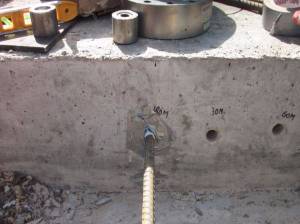Project 0-6611
Improvements of Full Depth Repair Practices for CRCP Distresses
Abstract
The Texas Department of Transportation (TxDOT) has by far the most continuously reinforced concrete pavement (CRCP) lane miles in the nation and sections as old as 50 years are still in service. Having served much longer than intended, some sections are showing distresses. FDR (full depth repair) is one of the methods to repair CRCP distresses in Texas. Over the years, various FDR methods have been used and the effectiveness of each method has varied. The most widely used FDR method – where a full-depth cut is made at 2 ft (30.48 cm) inside the transverse repair boundaries and partial-depth cut at repair boundaries with the concrete in between removed to expose longitudinal steel – has inherent disadvantages, with longer repair time required being the primary disadvantage. Full-depth cut FDR method – where a fulldepth cut is made at repair boundaries with transverse and longitudinal tie bars epoxy grouted into the existing concrete – has advantages over other methods, one of which is the faster operation, minimizing the time of roadway closure. Since CRCP is normally utilized at high traffic volume areas, the maximum time allowed for the FDR operation in TxDOT is normally limited to nine hours, which makes the fulldepth cut method the only acceptable repair method. Factors affecting the effectiveness of the full-depth cut method were investigated by laboratory testing and field evaluations. The way epoxy is injected into the holes was the most important variable affecting the performance of FDR. Based on the research findings, recommendations were made to revise specifications for FDR, and it is expected that the implementation will result in improved FDR performance of CRCP. Some distresses in CRCP are limited to the upper half of the slab depth, and for these distresses, partial depth repair (PDR) is the more effective method. A device called MIRA was evaluated for the detection of partial depth failures in CRCP. MIRA was able to detect not only delaminations, but voids and mud balls in concrete slab, reinforcement, and slab thickness. For the detection of partial depth distresses, MIRA can be a useful tool. Guidelines, special specifications, and design standards for PDR were developed.

Center for Multidisciplinary Research in Transportation (TechMRT)
-
Address
Texas Tech University, Box 41023, Lubbock, TX 79409-1023 -
Phone
806.742.3523 -
Email
techmrt.outreach@ttu.edu
